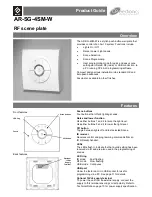
Operating Instructions
Zero-3 / 5-Channel Motor Controller
CNC-STEP e.K. ▪ Siemensstrasse 13-15 ▪ 47608 Geldern ▪ Germany
Page 14
Support: +49 (0)2831/91021-50
12.10.2012
4
Commissioning
4 .1
I ns tal lat io n
The controller should be installed in such a way that the controls on the front panel, especially the
E-Stop switch, are freely accessible at all times. There should be free air flow to the ventilation
openings on the housing.
Appropriate measures (housing, protective walls, suction ...) should be adopted to ensure that the
controller remains free of shavings, dust and liquids (oil, cooling water). Metal swarf and cooling
water can cause short circuits. Dust can interfere with ventilation and thus cause overheating. Both
of these can lead to irreparable damage and risk of fire.
4 .2
Pow e r s up ply li ne
The controller is equipped with a universal AC adapter and can be operated without adjustment
using line voltages from 115 to 240VAC. If you are operating the equipment in a foreign country
make sure that you use only appropriate and authorized power cord and power outlet adapters.
These must have a PE conductor and be designed for a load of up to 16A.
4 .3
Co n ne c ti ng t h e ma c h i ne
Connections for the positioning motors (connectors X1, X2, Y and Z), the rotating axis or tangential
unit (connector C), if present, and the end position switches and E-stop switches (connector ST) are
located on the front panel. Before connecting the connector make sure that the assignment of
individual contacts corresponds to the schematic shown below.
Incompatible connections lead to the risk of damaging parts of the
controller or destroying it.
In addition, the proper functioning of the system can be reduced through
this and safety functions which serve to protect life and limb can be
disabled.
Insert or remove connectors only with the controller switched off!
Always lock connectors using the screws located on the connector
housing. The electronic equipment is protected against short-circuits and
interruption of the motor cable. However, unreliable contacts can lead to
incorrect positioning and/or arcing, which can result in breakage of tools,
destruction of the workpiece or reduction of the service life of the system.













































